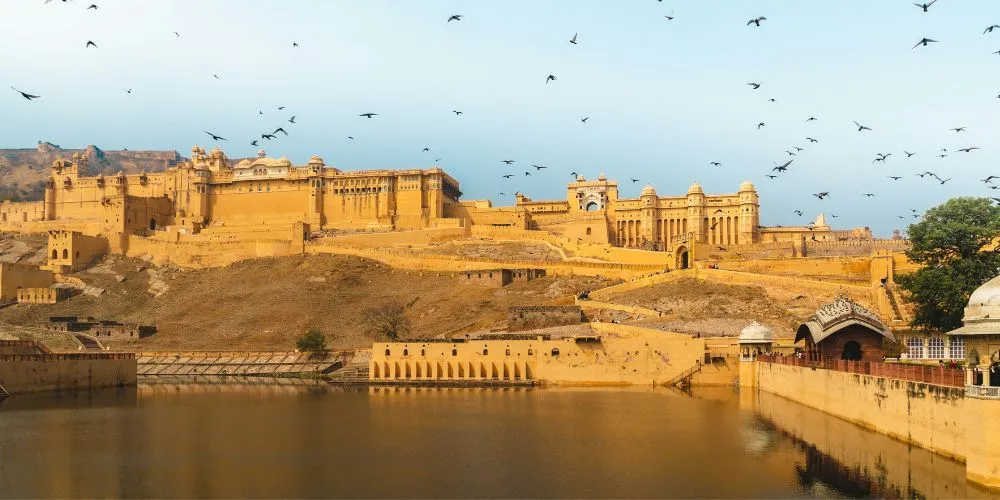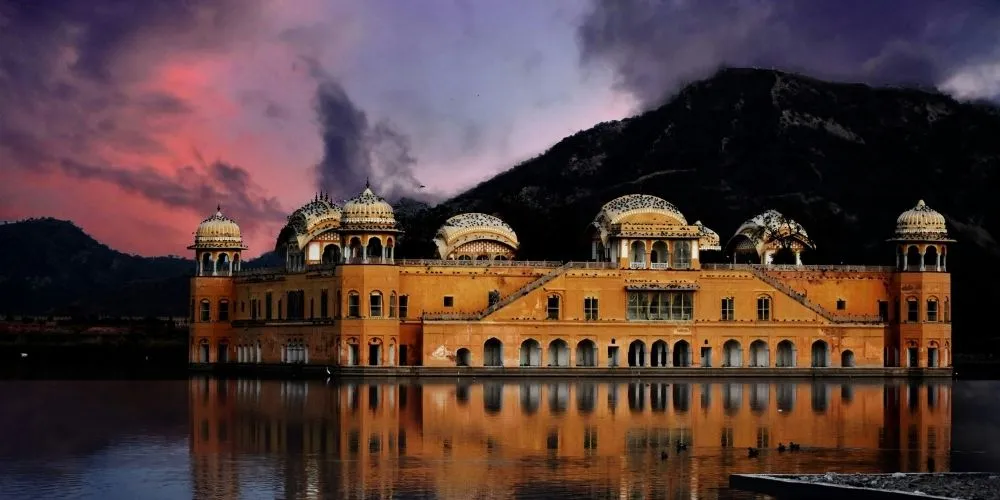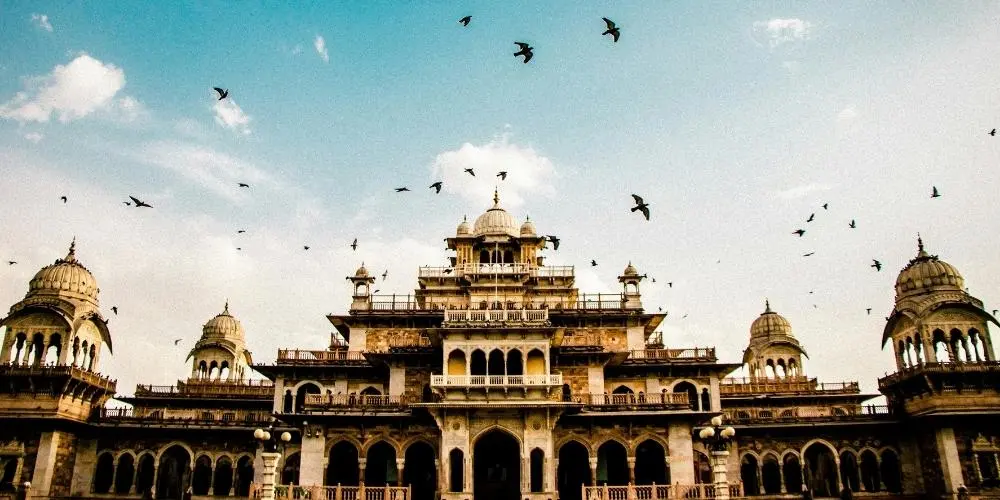Capital city of Rajasthan, Jaipur is an amalgamation of royal heritage and modern charm. Popularly known as the Pink City for its rose-hued buildings, Jaipur is famous for its majestic structures, royal palaces, bustling bazaars, and rich cultural tapestry. Jaipur is a city that interests avid travellers, history enthusiasts, seekers of cultural richness, and food lovers. It offers unforgettable experiences and flavours in equal measures. Though most people have visited this beautiful city at least once, they have still not explored every corner of this marvellous place. The city is a photographer’s paradise. Follow this guide to know when to visit, where to go, what to eat, where to shop, and how to get there.
Jaipur is a UNESCO World Heritage City that seamlessly blends royal grandeur with contemporary vibrancy. The city’s architectural marvels, such as the City Palace Jaipur and Hawa Mahal Jaipur, narrate tales of regal splendour. Jaipur’s colourful markets, folk performances, delectable cuisine, and welcoming culture make it a must-visit destination for travelers seeking an authentic taste of India’s royal past and lively present.
Best Time to Visit
The best time to visit Jaipur is from October to March, when the weather is cool and pleasant. This time is ideal for sightseeing, outdoor activities, and festivals. Winters bring vibrant events like the Jaipur Literature Festival and Makar Sankranti kite festival.
How to Reach Jaipur
Jaipur is well connected by air with regular flights from major Indian cities and international destinations to the Jaipur International Airport. Jaipur Junction is a major railway hub with frequent trains from all major cities. The city is accessible via national highways, thus, hiring a taxi, boarding a bus, or taking a self-drive car are all great options, especially from the neighbouring cities in the 500 km radius for a day’s journey.
Best Places to Visit in Jaipur
- City Palace Jaipur: Located in the heart of the city, City Palace Jaipur is a sprawling complex of courtyards, gardens, and buildings that showcase a fusion of Rajput and Mughal architecture. Built by Maharaja Sawai Jai Singh II, the palace houses museums displaying
royal costumes, weaponry, and artifacts. Don’t miss the Mubarak Mahal, Chandra Mahal, and the intricate Peacock Gate.
- Hawa Mahal Jaipur: The intricate latticework and red-pink sandstone structure are iconic symbols of Jaipur’s heritage. Built in 1799 the Hawa Mahal (translation: Palace of Winds) is an architectural masterpiece with its honeycomb facade and 953 small windows. The purpose of the Hawa Mahal was to let royal women observe street festivities while remaining unseen.
- Jai Mahal Palace Jaipur: Built in 1745, a heritage palace-turned-luxury hotel, Jai Mahal Palace is set amidst 18 acres of landscaped gardens. It was the former residence of the Prime Minister of Jaipur and offers a royal stay with period décor, lush lawns, and a tranquil ambiance. The Jai Mahal Palace is the perfect place to get a closer view of royalty and experience Jaipur’s royal lifestyle firsthand.
- Amber Fort: Perched atop a hill, Amber Fort is renowned for its artistic Hindu-style elements, grand ramparts, and scenic views. Explore its ornate halls, Sheesh Mahal (Hall of Mirrors), and enjoy an elephant ride up the ramparts for a royal experience.

- Jal Mahal: Floating in the middle of Man Sagar Lake, Jal Mahal is a picturesque palace known for its stunning architecture and serene surroundings. While entry inside is restricted, the view from the lakeside is mesmerising, especially at sunrise and sunset.

- Chokhi Dhani Jaipur: For a truly immersive experience in the rich rural culture of Rajasthan, a visit to Chokhi Dhani Jaipur is a must. This recreation of a village gives a closer look at the traditional Rajasthani life with folk dances, puppet shows, camel rides, and authentic cuisine served in a rustic setting. It’s a must-visit for families and everyone eager to experience Rajasthan’s hospitality and flavours.
- Jantar Mantar: This UNESCO World Heritage site is an astronomical observatory featuring massive stone instruments used to measure time and track celestial bodies. It’s a testament to Jaipur’s scientific and architectural legacy.
- Nahargarh & Jaigarh Forts: Both forts offer panoramic views of Jaipur and a glimpse into the city’s military history. Nahargarh is especially popular for sunset views, while Jaigarh houses the world’s largest cannon on wheels.
- Albert Hall Museum: Rajasthan’s oldest museum, the Albert Hall Museum, boasts an extensive collection of art, artifacts, and an Egyptian mummy. The building itself is a fine example of Indo-Saracenic architecture.

Apart from visiting the above listed spots, tourists can indulge in guided heritage walks, desert safari, elephant rides, and hot air balloon rides. Attend a traditional puppet show, Ghoomar dance, or Rajasthani music performance at cultural venues across the city. You can also visit the Moti Dongri Temple and Birla Mandir for a spiritual touch to the trip and watch a movie at the Raj Mandir Cinema – one of the oldest theatres in the city. Shopping for handicrafis, block-printed textiles, jewellery, and blue pottery at Johari Bazaar, Bapu Bazaar, and Tripolia Bazaar are also a great way to spend a day in Jaipur.
Best Resorts and Hotels in Jaipur
Jaipur offers a range of accommodations, from opulent palaces to boutique hotels:
- Jai Mahal Jaipur: Experience royal living at this heritage palace hotel, known for its lush gardens, regal rooms, and impeccable service.
- Rambagh Palace: Once the residence of Jaipur’s Maharaja, this luxury hotel offers a blend of history and world-class amenities.
- Taj Mahal Palace: A symbol of luxury, offering grand suites and fine dining.
- Samode Haveli: A boutique heritage hotel with traditional décor and modern comforts.
- Chokhi Dhani Resort: Stay in ethnic cottages and enjoy cultural performances, making it ideal for families and those seeking an immersive Rajasthani experience.
Use the Jaipur Metro, auto-rickshaws, e-rickshaws, or app-based cabs for convenient travel within the city.
What to Eat
Jaipur’s food is a feast for the senses, offering everything from royal delicacies to street food:
- Dal Baati Churma: A Rajasthani classic of baked wheat balls, lentils, and sweet crumbled wheat
- Laal Maas: A fiery mutton curry for spice lovers.
- Gatte ki Sabzi: Gram flour dumplings in spicy gravy.
- Ker Sangri: A unique desert-bean and berry preparation.
- Ghewar and Mawa Kachori: Traditional sweets, especially popular during festivals.
- Street Food: Try pyaaz kachori, samosas, mirch wada, patasee, and lassi at local stalls.
Conclusion
Jaipur is a city where every corner tells a story of valour, artistry, and hospitality. From the regal halls of City Palace Jaipur and the breezy windows of Hawa Mahal to the immersive experiences at Chokhi Dhani and the luxury of Jai Mahal Palace, the Pink City promises to impress with every aspect and offering. Plan your visit for the cooler months, indulge in local cuisine, explore the bustling bazaars, and let Jaipur’s royal charm sweep you off your feet.
By: Anushka Singhal
